Distinguished leaders, guardians of liberty and freedom, friends of the forces that prowl the great seas from the deep, ladies and gentlemen I am extremely grateful to join you this evening. It is like returning home from a faraway land following an extended absence returning home for Christmas, back within the warm confines of close friends and family. It is truly an honor and a joy to be here.
The news media, social media and the internet have been aflame for the last year or two with “fake news.”
This poorly defined term covers a wide range of related issues: pro paganda, satire, alternative facts, yellow journalism, misinformation, disinformation, partisan bias, advertising and spin. These concepts are, of course, not new, but what is new is the scale at which any of these kinds of manipulative story can create influence given the speed with which unfiltered material spreads on the internet.
Everyone is fixated on the “fake” part of “fake news.” I am not sure that is really the right area to worry about. The root of the problem, I think is the “news” part, not the “fake” part. The reason so much false material gets so much traction is really, in the end, about the speed of the news cycle and our ADD like attention spans about the fact that we only monitor “news.”
When there is no time to process a story, to hold it up to the light, to see how other news outlets react to the story, there will always be room for errors both accidental and malicious. If there is no time to root out the misleading stuff, the fake or biased stuff sticks, and we roll on to the next item in our news feed or the next tweet.
I think that most of the challenges we face as a society and especially most of the challenges we face as a Navy and a submarine force are not in the “news” category of things that Steven Covey would have called “urgent.” Covey always argued that people were too prone to allowing the “urgent” to crowd out the “important.” News is urgent, by definition. If it’s been around a while, it’s not news.
Our biggest problems are in the “important” category, the snail mail category, the category of “frog in the pot” stuff. These are the long term trends that never make it onto the crawler on the bottom of the TV. But these issues are important. They are huge, or maybe UGE. And if we are mistaken about the big, important stuff, we are in trouble.
If you have the wrong strategy, the best tactics in the world cannot bail you out.
I think my biggest concern is in the strategy area, the slow moving, not news area.
I want to talk about three macro trends that have been going on in the background. They are areas in which I worry that we are the frog, and the heat is going up and we are confronting our last moment where we can make one leap and get out of the pot before we are cooked.
The three areas where the world has taken a turn and we missed it are these:
1. Unreal Fiscal Realities
2. A Cold War that didn’t end.
3. An inflection point in naval investments.
In each of these areas, holding onto the past perception, the old paradigm, is impeding our ability to see what we should be doing. And it is affecting the choices that we make.
Let me make another comparison.
Probably a large portion of the people in the room have been involved in a formal critique at some point or another. Credit Naval Reactors for instilling in our culture an appreciation for the power and value of a good critique.
Critiques, like the incident reports that sometime go with them, focus to a large extent on getting at the root cause or causes behind a problem. For completeness they deal with the short term corrective actions how we handled the breaking news but NR has always been way more interested in the Root Causes and the Long Term Corrective Actions.
Getting at the root cause has always been the hardest part of any critique. It’s the part of the investigation that gets at what is important, not just urgent. And if you think about it, how often have you gone into a critique thinking you know what the answer is, only to come out the other end having learned that things were very different from what you thought?
I am going to make a case that we have been going through life on these three topics like a submarine crew that never does a critique.
(We should not feel too guilty on this, because it is really hard to notice these kinds of issues when you are busy in hand to hand combat in your fox hole. That’s why an off site event like this is helpful.) We are the crew that is not doing critiques, and we are not noticing that the short term corrective actions are not enough and never will fix the problem
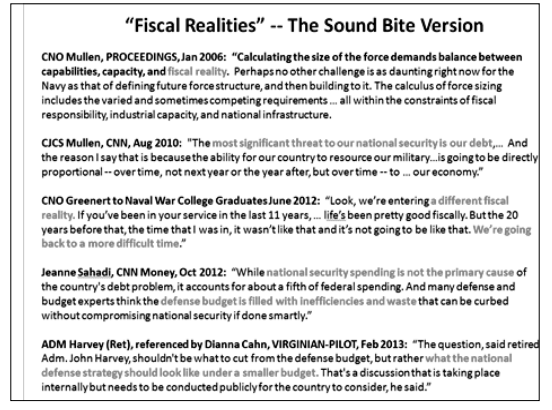
We have been watching tweets and dealing with urgent, near term actions, but we have taken our eye off of the macro trends and we missed the fact that the world took a turn.
Topic Number One: “Unreal Fiscal Realities”
Many of us will remember a number of these items in the “news” over the last several years. They paint a clear picture. “We in the Navy need to understand that the country is facing severe budgetary pressure” and “there is not enough money to do all the things we need to do.” We are creating debt that we are passing to our children. We are creating debt that is going to divert more of the budget to paying off interest on the debt. We just don’t have the money.
That’s the root cause a lack of resources. That’s the fact the “reality” that we have gotten in our heads when we did no critique and just accepted “news” reports without any critical thinking.
As a result, we have accepted a flawed version of the problem and we took corrective actions that were designed to address the wrong root cause. We sought to deliver Navy capabilities in light of the reality of a “fiscally constrained environment.” Indeed, as ADM Mullen famously pointed out, the most important part of our national security is our economic security.
We know the story. Because of the lack of fiscal resources, we were told to redouble our efforts to deliver capability more cost efficiently. We were told we needed to figure out ways to do our job with less money. We had to learn to figure out what we can do without and make the cuts required.
We were told that anyone who doesn’t think this way is ignoring “fiscal realities” in other words, is not being realistic. Everybody knows this is what we must do, right? Anyone who thinks otherwise is out of touch, right?
Every one of the authors of these quotes are responsible individuals who are smart and in positions of influence.
But that doesn’t mean that they are immune to being swept up in a sort of wave of collective thinking. We are all vulnerable to this. Even the people who do budget numbers for a living can get swept up in the story.
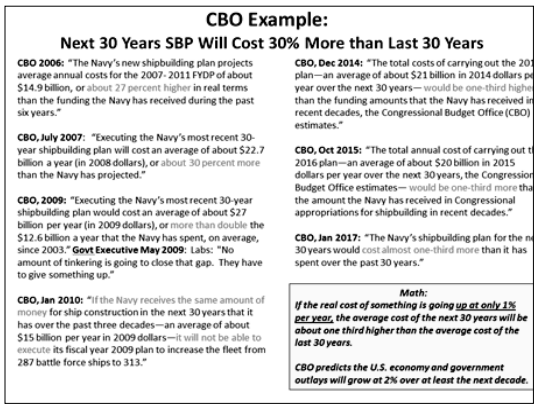
Here is an example. For a decade, the CBO has reported on Navy shipbuilding with a very consistent theme: the future 30 years of Navy SCN will require a third more money for shipbuilding than the past 30 years. The message in each CBO report is that the Navy is unrealistic to hope for this much more money.
Now, let’s think about this. We can do some math. If you have ever played around with compound interest, you probably instinctively know that it doesn’t take a very big interest rate to grow something so that the average over the past 30 years grows 30% when I continue that into the next 30 years. In fact, if you do the math, a growth rate of just under 2 percent per year will result in something that matches the CBO’s indictment.
But let’s remember that the federal budget outlays have grown at over 3% per year over the last 30 years, and even CBO says they will likely grow at 2 percent for the next 30 years. What that means is that the Navy need for money to build ships is growing at a rate smaller than the rate at which the federal coffers will grow.
What the CBO tells us to be ashamed of is, in fact, much slower Navy budget growth than the growth that is totally acceptable in the federal budget as a whole. In fact, we have done a sampling of CBO reports in other areas of the budget that are growing at rates higher than the Navy’s, and they do not include a corresponding slap on the wrist to “Get Real!” Yet the Navy is prodded to feel guilty for growing at a rate of 2% per year? Why?!?
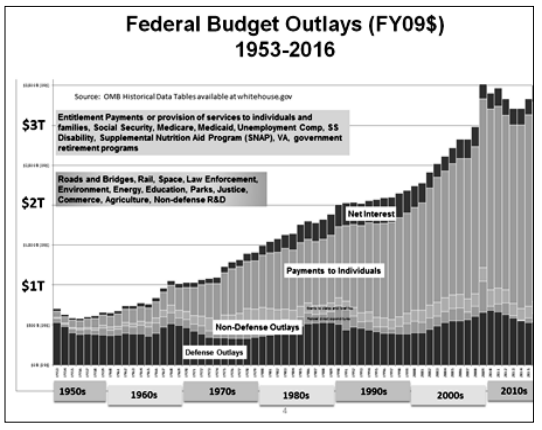
But here is the real lesson. Here are the insights from the critique we should have been doing all along. This is data from the OMB historical data tables downloaded from whitehouse.gov. It is pretty unimpeachable as a source. It is not fake news, it is our federal government’s official public record of its spending, available on the internet for every citizen. And it is history, so it does not involve analytical speculation or estimating or forecasting about the future.
What does it show?
First, this data is federal outlays. We looked at actual expenditures because that shows priorities in the clearest terms It captures where we have put our money as a nation.
Second, all the data is in constant year dollars 2009 in this case. The inflation has been removed. All the growth you see is real growth.
Third, the time frame is 1953 to the present. We picked that to be able to see the baseline before God created nuclear submarines, and we wanted to see the late 1950s Navy build up, the Reagan build up, and up to the present.
At the bottom is the Navy budget. It is between $100B and $200B the entire time. The high point was during the Reagan administration. The rest of the blue is Defense outlays. You can see that it is basically a rolling cycle with an overall flat long term growth.
The orange and reddish gold layer above that is all of the rest of the basic government services. Everything you learned about in middle school is in that little layer. That is where you find education funding, roads and bridges, highways, railroads, environmental protection, medical research, the national science foundation, law enforcement, the judicial system, federal courts, agriculture, FDA, EPA, FAA, Pell grants, endowment of the arts, PBS, commercial loans, energy infrastructure, waterways, dams, levees, parks, rangers, museums, federal buildings and infrastructure, the space program, GPS, NOAA, NASA, and on and on.
The gray layer that starts small on the left and grows to the right is what OMB calls “payments to individuals” (not salaries or payment for services provided), but what we typically call “entitlements.” It is Social Security, it is Medicare, it is Medicaid, it is unemployment compensation, it is disability pay, it is Supplemental Nutritional Aid or Food Stamps, it is school lunches. It is money that is moved from some members of the population and given to other members of the population, either in cash or in services.
On the very top is a purple layer called interest on the debt. You might notice that debt service has been pretty small lately, even though the accumulating debt is quite large. That is more a function of the interest rates. The CBO expects this number to get much larger in the future as the Fed adjusts interest rates back up toward normal rates near
3 percent from their current levels near zero.
I know this is a lot to absorb so late in the day, so let me distill this down into a few facts:
• The federal government took in more money last year than ever, total and per capita.
• The federal government spent more money last year than ever, total and per capita.
• The amount of money spent by the federal government has grown by a factor of 4 to 5 times since the 1950s, but defense spending has grown very little or remained flat.
• Let’s talk sequestration. The basic rule of sequestration was that cuts to non-defense discretionary spending (the yellowish orangish part of the slide) have to be matched by defense spending cuts. Sequestration did not address “mandatory” spending (the entitlements within the gray).
So, what is the real problem? It is not a lack of money, it is a lack of money for defense and for the Navy. You can see it on this chart as clear as day. The issue is a matter of Priorities, not Resources. The money is there, but we as a Nation are choosing to spend it on different things than defense and the Navy.
That is not a “reality,” that is a policy choice. Policy Choices are not carved in stone “laws of physics” that we must live with. Policy Choices can be shaped and influenced.
When we tell ourselves that “resource constraints” are a matter of “realism,” we are identifying the wrong root cause and the corrective actions we identify are going to miss the mark. We should never use the term “fiscal realities” to mean that we in defense must think of ourselves as “resource constrained” while the rest of the federal budget grows at a rapid rate.
My recommendation would be to purge the term “fiscal realities” from your vocabulary and challenge the thinking of others who use that term. To use the term “fiscal realities” is to imply that we should accept the current resourcing of the Navy as something beyond our influence. When you say “we must acknowledge fiscal realities,” you are in effect giving yourself permission to drift down the river, taking you wherever the current leads.
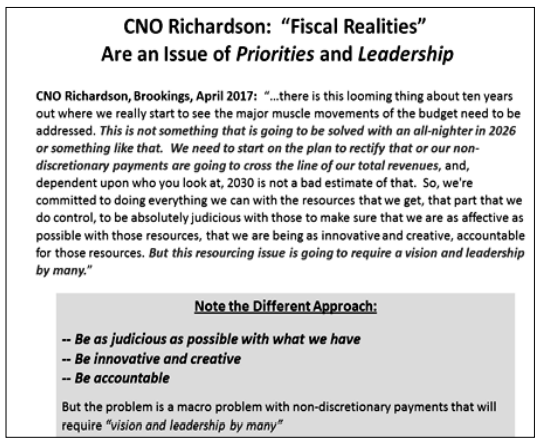
I want to discourage this passive approach. You have paddles in your canoe. Pick them up and start paddling where you want to go. What we are confronting are not “Fiscal Realities,” they are “Funding Priorities.” Now, there is a challenge that comes with a clearer view of the real Fiscal Realities our job is to influence budgetary priorities more effectively. Look at the testimony and statements of the CNO. He is not passively accepting fiscal realities.
If we understand that shaping budgetary priorities is the “long term corrective action” to fix a resource shortfall, we will start to implement measures that will actually help fix the problem.
Until now, we have been choosing programs to cut that which we know really should be funded. We have had to make contrived cases about why it is okay not to have antiship missiles in the submarine force or the surface navy, about how we can go twenty years without a heavyweight torpedo production line, about how it is okay to take years to put an F18 through modernization. We have been “taking risk” over the past decade or two, and there are things we have not done that should be reconsidered.
So, the real root cause for an under resourced Navy is a lack of appreciation of the importance of the Navy and why it should have a higher funding priority, especially as we look ahead. That is a burden on all of us as leaders of the Navy to make that case. When we just “mind our panel” and “take our medicine” we are not addressing the real root cause, and the problem will continue and so it has. Are you with me?
There is a second area where I worry that we have been spending too much time with the urgent, news, immediate corrective action side of the ledger instead of the important, long term side of the ledger:
The Nature of the Threat
The issue is this: What kind of struggle are we preparing for? What kind of adversary are we planning to face? Are we preparing for a major conventional war? Are we preparing for a nuclear war? Are we preparing for a long term war against radical Islamist fighters? Are we developing “capabilities” in some kind of vacuum as if we have no idea when or where they might be used, and against whom?
Over history
For many people, the role of the Navy has looked like this:
• We helped win the war against the Nazis and Imperial Japan
• We won the Cold War
• We are helping with the GWOT, War against ISIS
• We are trying to figure out if we are going to have to fight again soon.
This is a Navy engaged in either War or Peace or support to the war ashore, and I think it is the wrong picture. We have lost a clear vision of the true threat based on a recent aberration in history without an existential threat from a major global power. Let me give you two contrasting cases. Imagine that I ask you, in one case, that you need to figure out how to defeat ISIS in a year. Now imagine a second case where I tell you that we are going to be engaged
in a 100 year war with ISIS and you must get ready for that.
How different are your preparations and investments and intended operations for those two cases? They are very different. They are radically different. They are not even close to being the same.
Now, I don’t want to talk about ISIS and how long a fight against them will take. I want you to consider that the fight against ISIS is only one battle or one campaign in an ongoing long term hundred year war that is not a religious war at all it is a struggle on behalf of free societies threatened by oppressive authoritarianism.
We need to think about it from a different perspective:
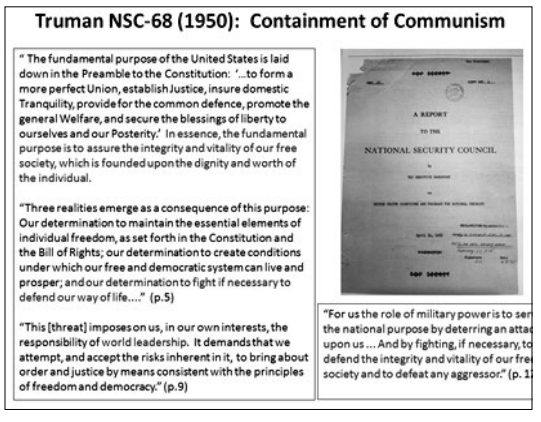
We have spent at least the last 80 years deterring or fighting against oppressive/authoritarian regimes. These regimes are threatened by the existence of free democratic states. We fought the totalitarian Nazis and Japanese and Italians in World War II. Then we faced the first Berlin crisis and the need to face global Communism.
By 1950, we had adopted a strategy of Containment, with themes that were very familiar to a group that had just finished winning World War II: defend the integrity and vitality of our free society/defend our way of life.
The United States realized that we needed to assume a position of leadership in the world, that we had to invest in a strong military, that we needed to construct a world order based on freedom, democracy and free trade and be prepared to defend that world order.
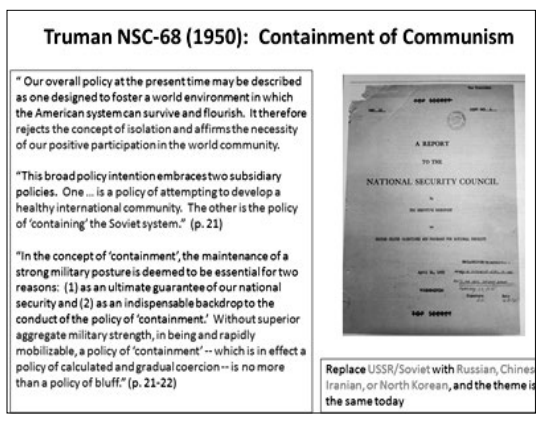
We realized that we needed to practice deterrence; that nuclear forces would be part of that deterrent posture, and that small scale conventional fights and struggles for influence would be the backdrop. NSC 68 was the name for this Top Secret/world view and approach.
You can google it and read it today, because it has been declassified. It is very interesting reading. (The bureaucrat who signed the declassification notice on the front was some guy named Kissinger.) These themes should be familiar to us today. But just to reinforce the point.

In 1982, Reagan was doing the same thing. This time the document was NSDD 32 the Top Secret National Security Strategy. That is also declassified and you can read it, along with the vast majority of the scores of other NSDDs of the Reagan administration. Reasserting global leadership against an oppressive and authoritarian Soviet Union, rebuilding the military and working to protect a global system supportive of freedom. Same themes as NSC-68.
That is what NSC-68 said in 1950, what NSDD-32 said in 1982 (32 years later) and it is where we find ourselves again in 2017 (35 years later).
We have gone from the Nazis and the Japanese in World War II to the Soviets, and now the Russians//the Chinese//the North Koreans, the Iranians, the Syrians, the Serbians and the Libyans, and now the various radical Islamist extremists: all were or are oppressive authoritarian regimes.
It is important to note that we have not spent our history fighting every oppressive authoritarian regime in the world such a goal would be unachievable but when we have fought, it has always been against oppressive authoritarians that have been expansionist or otherwise challenging the liberal world order. When the threat is big enough and proximate enough, we fight…when it is more remote, we hold.
Think of all the places TLAMs have fallen: they have fallen on oppressive authoritarian regimes, either state sponsored or not. In each case, the interests we were protecting were those of the free world… sometimes directly, and sometimes indirectly.
The same Bad Actors with maritime access are the ones we have had to deal with: Russia, China, North Korea, Iran. It was this list of countries and groups when I was born, it was this list of countries when I was an Ensign, and it is this list of countries now.
Notice that it doesn’t make a difference that the Cold War is “over.”
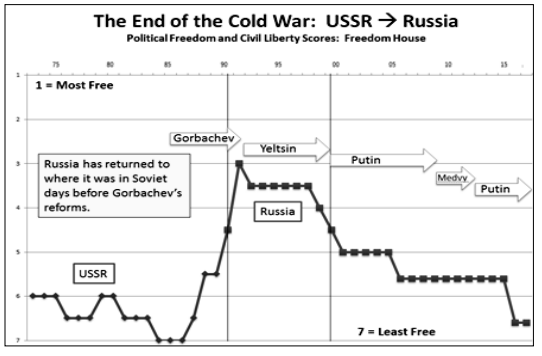
When the USSR came apart, Russia tinkered for a few years with liberty and then plunged literally back to where it was before Gorbachev started his reforms. The USSR wasn’t the way it was because it was Communist, it was Communist because of the underlying authoritarian nature of the society.
When Communism’s inherent weaknesses became inescapable, it was tossed as a philosophy, but not the authoritarianism. Look at what happens to Freedom in the USSR after this brief experiment.
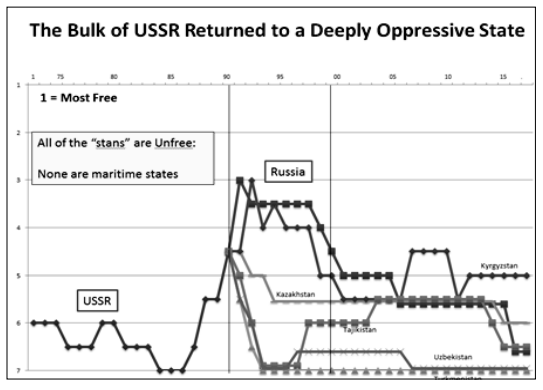
If we look at all of the Soviet Socialist Republics, we see an interesting effect. The Stans all immediately return to being Unfree as soon as the Soviet Union dismantles. This is basically what happened to Russia as well. A liberal experiment, then back to authoritarianism.
To see what we are struggling with today, let’s look at what happened to some of the other SSRs.
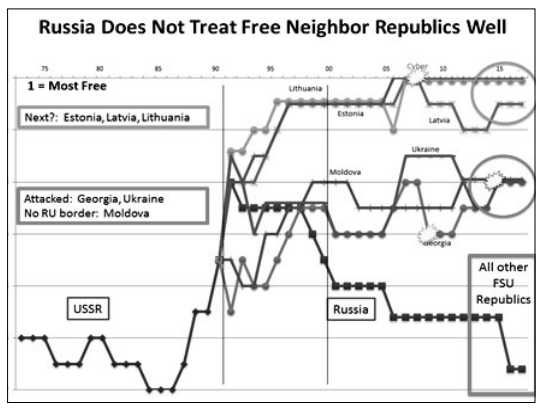
The Baltic states immediately became Free and are in the orange circle at the top right. What happened then? Estonia soon becomes the victim of the world’s first large scale cyberattack designed to bring an entire country to its knees.
Some other states became Partly Free, in the red circle.
What happened to them? Well, Moldova is insulated from Russia by Ukraine, so nothing happened to it. But the other two are Georgia and Ukraine. Both have been attacked by Russia and in the case of Ukraine portions remain occupied.
Do you see a pattern? Is there any question why the Baltic states are feeling the heat from Russia? Just as NSC-68 and NSDD-32 described years ago, this long-term struggle is between the Free World and Authoritarians who are inherently threatened by nearby prosperous, free countries. Just as NSC-68 described, the authoritarian nature of Russia makes the presence of a prosperous Free state on its border a threat that requires action.
That is why the Ukraine was attacked and a buffer layer was peeled off. That is why Georgia was attacked. That is why Estonia was attacked and that is why the Baltic states are as anxious as they are. That is why China has never considered a re unified Korea it would become a free nation on the border of China. That is why Taiwan is threatened. That is why Tibet and Taiwan and the South China Sea are vital national interests for China.
We would do better to think of our role in the world not in terms of tweets and crawlers on TV, but in long-term NSC-68 terms. We are the leader of the Free World and we are the anchor of principal, long-term resistance to the spread of Oppressive Authoritarianism. We in the Navy are especially called out to resist this spread if the effort spreads to the maritime domain. Our grandparents were doing the same thing.
We can, as a result, think of this as a struggle that has lasted generations and will most likely last generations more. If we think this way, it makes us aware of the need to not only resist coercion with large scale military efforts by Russia or China, but also to resist lower level intimidation in regional areas, to resist the erosion of the free world by low level but sustained coercive pressure. It helps us think in terms of the long view. After all, that is how Red thinks!
If we think of our task this way, we are likely to envision that a different tool-kit is desirable. Of course, we need to ability to deter nuclear war, to fight and win high end conflicts…but that will not be enough. We also need to win a struggle for influence that does not involve major conflict, which uses other means and lower levels of violence.
We need to win the “competition for influence.” This effort may perhaps require some different kinds of capabilities, including non lethal or scalable effects, disabling capabilities, and perhaps some capabilities that are better adapted to better interoperability and cooperation with less prosperous but free countries.
This is a harder problem, and a different problem. But this is the real root cause we have to correct. We are not firemen waiting for some random alarm to sound so we can react to it. We know where the arsonists are, and we need to be watching them from very close range.
So, what actions do we need to take as we leave this symposium?
Navy Investment Turning Point
My third and final point: We are at another pivotal turning point in Naval Investments and we can’t afford to miss it. We must adapt to this changing environment, fiscal and threat environment, and we must do so urgently.
We have, in the past, been absorbing cuts, killing programs we should not have killed, putting gaps in modernization and readiness that were not okay, and cancelling submarine refueling. But we had no choice.
But now we are at a turning point. We have an administration with a formal position that we need to invest more heavily in defense and in our Navy. We need to echo that message and make sure that it is reinforced. We have emerging maritime adversaries in multiple theaters who are challenging the liberal world order of free societies.
The Cold War never ended for them, and that means it never really ended for us. We are still the leaders of the Free World, and the Free World will not defend itself without effort.
We are engaged in a long term struggle that is not going to end soon. As long as Russia, China, Iran and North Korea remain authoritarian, we will need to protect the global system and remember, they have all been authoritarian for the entire lifetimes of everyone in this room.
The fact that in the past we could not invest in readiness does not mean that we are not going to invest in readiness now. We are: it is recovery priority number one. Then we are pushing our capacity up by starting growth using the major programs for which we have warm production lines. Then we are expanding to include the introduction of a variety of disruptive new capabilities: unmanned, offboard, distributed systems, sensors, and so on.
Don’t worry, by the way, about 355 ships or 350 ships or whatever. Another look at history would show you that we have never ever reached a target fleet level before the circumstances driving that number changed. This much is clear, though: we know that we are going up, and not just a little bit. Never mind the number. We know we have too few ships and that our industrial capacity is less than the number we need to build each year.
Conclusion:
In summary, I ask that you recalibrate your picture of reality to look at some of the longer-term but more important trends include these features:
• A budget chart showing that it is not the Navy, or defense, or core government functions that are creating budgetary pressure, and cuts in these areas are not the solution.
• An image of history showing that the Russians, Chinese, Iranians and North Koreans are the same totalitarian, authoritarian oppressive expansionists that they were 70, 50 and 30 years ago, and we need to view our important global role with that kind of long term perspective.
• That navy investment is hitting an inflection point and we need to make future decisions based on different rules than the past. Some things we did not fund need to be resurrected. Some things we have not considered need to be in the program. Our investments need to be mindful of the long term struggle that we are in.
We have a rare opportunity that a generation of naval officers before us did not have, and wished for. It has fallen onto our shoulders to carry out this responsibility, this sacred calling.
I close with a quote from George Washington from 1788:
“No country upon the earth had it more in its power to attain these blessings of liberty and freedom than United America. Wondrously strange, then, and much to be regretted indeed would it be, were we to neglect the means and to depart from the road Providence has pointed us to, so plainly.”
We are the leader of the free World. Let’s get after it.

